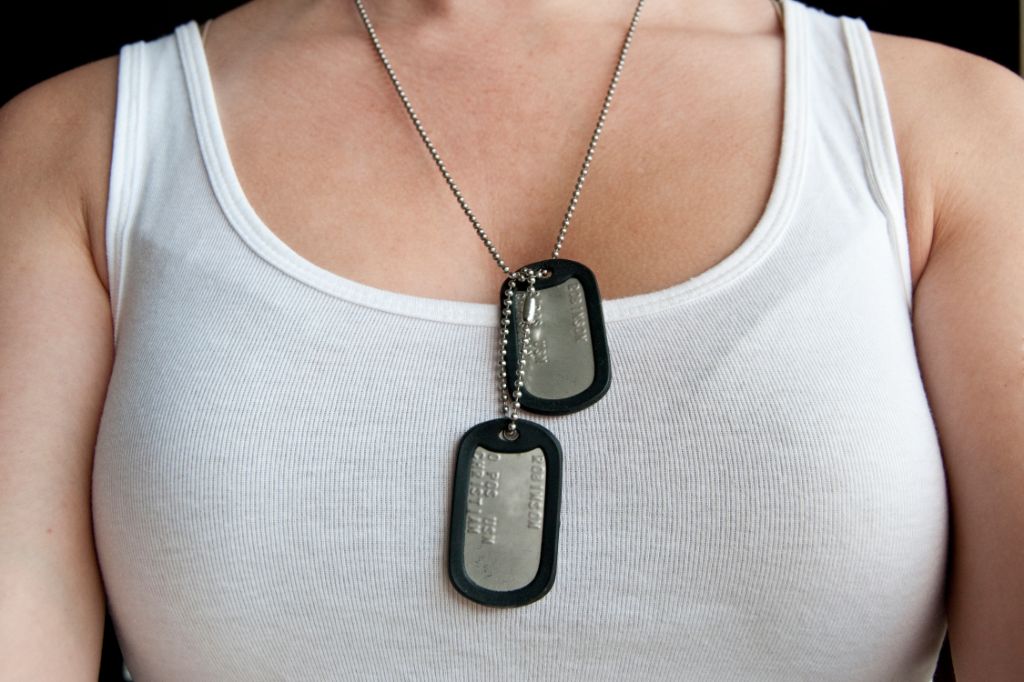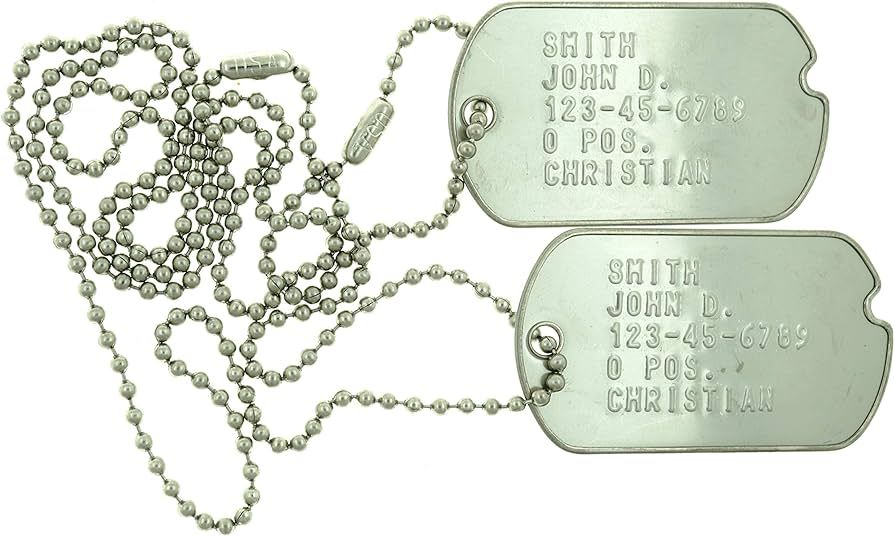Introduction to WW2 Dog Tags
Dog tags are identification tags worn by military personnel to identify soldiers if they are killed in action. They have been an essential part of a soldier’s gear for over a century. While the earliest forms of identification tags date back to the Civil War, the U.S. Army first officially authorized the use of identification tags in 1906 [1]. By the time World War II began in 1939, dog tags had become standard issue for all U.S. military personnel.
In preparation for the United States’ entry into World War II, the Army Quartermaster Corps redesigned and standardized the military dog tag in 1941 [2]. The new tags were oval-shaped with a hole for stringing them together on a single chain. Soldiers were issued two identical tags, usually worn around the neck. If a soldier was killed, one tag would remain with the body while the other would be collected for record keeping. This way, each soldier could be identified and accounted for.
The dog tags issued during World War II included vital information such as the soldier’s name, serial number, blood type, and religion. They served the essential purpose of quickly identifying personnel and notifying next of kin in the event of a combat death. Dog tags were a ubiquitous part of a soldier’s standard gear throughout the war.
What Information Was on WW2 Dog Tags
WW2 dog tags contained several pieces of personal information about each soldier. This included:
- Full Name
- Serial Number – The Army serial number was a unique number assigned to every soldier upon enlistment.
- Blood Type – Knowing a soldier’s blood type was critical for administering emergency medical care on the battlefield.
- Religious Affiliation – Soldiers could specify their religious affiliation, usually as P for Protestant, C for Catholic, or H for Hebrew.

Requiring this personal information on WW2 dog tags served several purposes. First, it allowed medics to quickly identify a wounded or deceased soldier and have access to critical medical information like blood type. The name and serial number also ensured that soldiers who were injured, killed, or missing in action could be accurately accounted for. Finally, the religious affiliation assisted chaplains in providing last rites or burial services aligned with a soldier’s faith.
Materials and Design
WW2 dog tags were made from stainless steel or aluminum. Steel was the preferred material due to its durability and resistance to corrosion. Aluminum was lighter but more prone to damage. The dimensions of the dog tags were 2 inches long by 1 1/8 inches wide with rounded or notch-shaped corners.

The rectangular shape allowed enough space for imprinting the necessary soldier identification information on each tag. One tag was worn around the neck, while the other was kept inside the shoe. The pair of identical tags helped ensure that if one tag was lost or damaged, the other would still provide critical information to identify the soldier if killed or wounded in action.
The tags had a small hole punched at one end for stringing onto the necklace chain. The rectangular shape and stainless steel material made the dog tags durable enough to withstand the rigors of combat. The stainless steel didn’t easily bend or break and was resistant to rust and corrosion. This ensured the imprinted information would remain legible throughout the soldier’s service.
How Soldiers Wore Dog Tags in WW2
In WW2, soldiers wore two identical dog tags around their necks on a cord or chain. One tag was meant to remain with the body, while the other was collected for record keeping. Having two tags was a change from WWI, when soldiers only had one tag each.
Dog tags were worn under the uniform, directly against the skin, on a cord around the neck. The Army favored beaded necklace-type cords, while the other branches used braided lanyard cords (U.S. Army WW2 Dog Tags). These cords allowed the dog tags to be tucked into the undershirt to avoid dangling or noise that could reveal a soldier’s position. However, some soldiers chose to wear their dog tags outside their uniforms as a visible display of their identity.
The two-tag system was an improvement over WWI’s single tag because it helped ensure identification if one tag was lost or damaged. The Army’s Quartermaster Corps advised each soldier to wear the tag marked “1” around his neck, while tag “2” would be removed upon death for record keeping. However, in practice soldiers often wore the tags interchangeably or distributed the pairs between boots and necks.
Customizing Dog Tags in WW2
Soldiers in WW2 frequently personalized and customized their standard-issue dog tags to reflect their individuality and personal flair. Though the dog tags contained standardized information like name, serial number, and blood type, soldiers would often etch additional information or add decorations.

One popular customization was etching a soldier’s hometown or home state on the tag, providing easy identification if injured or killed in action. Soldiers would also sometimes etch humorous sayings, lyrics from songs, or heartfelt messages on the tags as mementos and reminders of life back home. Etching initials of loved ones was also common, especially girlfriends or wives. Soldiers also etched their religious affiliations, such as a cross or Star of David, on their dog tags (My Dog Tag).
Beyond etching, some soldiers attached colorful cloth or ribbon to create lanyards for their dog tags. This served both decorative and functional purposes, as the lanyard prevented the tag from dangling loosely. Soldiers got creative with materials, using shoelaces, pieces of parachute cord, strips of cloth, or braided horsehair. The customized lanyard became another way for soldiers to show their individuality (WWII Dog Tags).
Though customizations were discouraged by some commanders to maintain uniformity, they proved popular among troops as a means of personal expression. The customized dog tags of WW2 soldiers remain treasured keepsakes and insights into the lives of those who served.
Dog Tag Distribution in WWII
Soldiers were first issued their identification dog tags during basic training. Before deploying overseas, they would receive an updated set with their unit information included. According to https://www.mydogtag.com/military/wwii/1941-1943-army, each soldier received two dog tags – one to wear around their neck, and a spare tag that was kept in the left shoe.
If a soldier’s dog tag was lost or damaged, they could request a replacement by submitting the proper forms to their commanding officer or supply depot. The process included filling out a Statement of Identification Tag Lost or Destroyed form, and could take several days or weeks depending on where the unit was stationed. Multiple lost tag incidents could result in disciplinary action. The military took the identification tags very seriously to quickly identify casualties in combat situations.
Importance of Dog Tags
Dog tags served an incredibly important purpose during WW2. Most vitally, they provided identification if a soldier was killed or injured in battle. The tags contained critical personal information so that the military could identify the soldier and notify their next of kin. This gave families closure and helped honor the sacrifices of the fallen. As described on the U.S. Army’s website, “The ‘sole’ purpose for wearing ‘Dog Tags’ was to enable positive identification of a casualty or remains, and to make a difference both for the families and the burial details” (U.S. Army WW2 Dog Tags).
Beyond identification, dog tags also provided soldiers with a sense of identity and morale boost. The tags were a source of pride – they showcased each soldier’s name, serial number, blood type, and religious affiliation. Soldiers personalized their tags to reflect their identities. As explained by the U.S. Department of Defense, having identification tags “gave soldiers reassurance that their body would be identified in the aftermath of war and gave them a sense of identity” (Dog Tag History: How the Tradition & Nickname Started). The dog tags were a symbol of the duties and sacrifices soldiers made for their country.
Dog Tags After the War
When soldiers returned home from World War II, many kept their dog tags as mementos while others discarded them. After being discharged, soldiers were no longer required to wear their dog tags so many saw them as relics of their service that they preferred to leave behind.
Some soldiers mailed their dog tags home to their families. Others swapped with fellow soldiers from different units as keepsakes. Many buried their dog tags, and excavated WW2 dog tags are still occasionally found today at former campsites and battlefields.
Over time, WW2 dog tags have become valued collector’s items. Military collectors and history enthusiasts often seek out original WW2 dog tags to preserve memories of those who served. Online auction sites like eBay have listings for individual WW2 dog tags or sets identifying the soldier’s name and service details. Collectors may pay higher prices for dog tags that belonged to notable individuals or units.
Museums like the National WWII Museum in New Orleans have WWII dog tag collections to honor and remember the soldiers who risked their lives. The stories behind the names on these dog tags provide insights into the realities of military service and sacrifice during wartime.
According to the National WWII Museum, “Though the dog tags themselves sometimes ended up discarded on the battlefield or abandoned on the way home, their words have endured beyond the men who wore them as a testament to service and a means of remembrance.”
Notable Stories About WW2 Dog Tags
Many soldiers in WW2 had unique stories and connections to their dog tags. According to the Washington Post article (https://www.washingtonpost.com/history/2023/11/11/wwii-bomber-dive-dog-tag/), divers recently found a corroded dog tag in a sunken WW2 bomber. The tag likely belonged to one of the bomber’s crew members and had been underwater for nearly 80 years. Though the name was no longer legible, the discovery provided a poignant link to the fallen soldiers.
Sometimes soldiers would customize their tags by scratching messages into them. Others carried sweetheart tags with a loved one’s name or photo engraved on them, as described in the Med Dept article (https://www.med-dept.com/articles/u-s-army-ww2-dog-tags/). The tags represented a symbolic connection to their lives back home.

Many veterans kept their dog tags long after the war. In one instance covered by WTHR (https://www.wthr.com/article/news/local/french-gardener-finds-wwii-veterans-dog-tags-returns-them-home-to-anderson-indianapolis/531-ebefb467-b207-41d8-acee-f5e9e762738e), a French gardener found a soldier’s WW2 dog tags over 20 years after his passing. The gardener made sure to return them to the veteran’s family in America, providing closure and reuniting them with an important memento.
These stories showcase how dog tags encapsulated memories of service, sacrifice, and loved ones for WW2 soldiers. The tags bore witness to the war and sometimes outlived the men themselves as haunting historical artifacts.
The Legacy of WW2 Dog Tags
Dog tags have become an iconic symbol of military service and sacrifice since their widespread use in WW2. The basic two-tag design used in WW2 went on to be implemented in later conflicts like the Korean War, Vietnam War, and beyond. While the materials and information included have evolved over time, the idea of having identification tags for fallen soldiers continues to be standard practice for the U.S. military.
Beyond their practical purpose, dog tags also carry deep emotional significance. They represent the willingness of soldiers to make the ultimate sacrifice for their country. Many soldiers choose to give a dog tag to loved ones before deploying. The tag serves as a reminder of their service and an object to honor in the event they don’t return home. Even decades after WW2 ended, dog tags continue to represent the courage and dedication of those who fight for our freedom.
